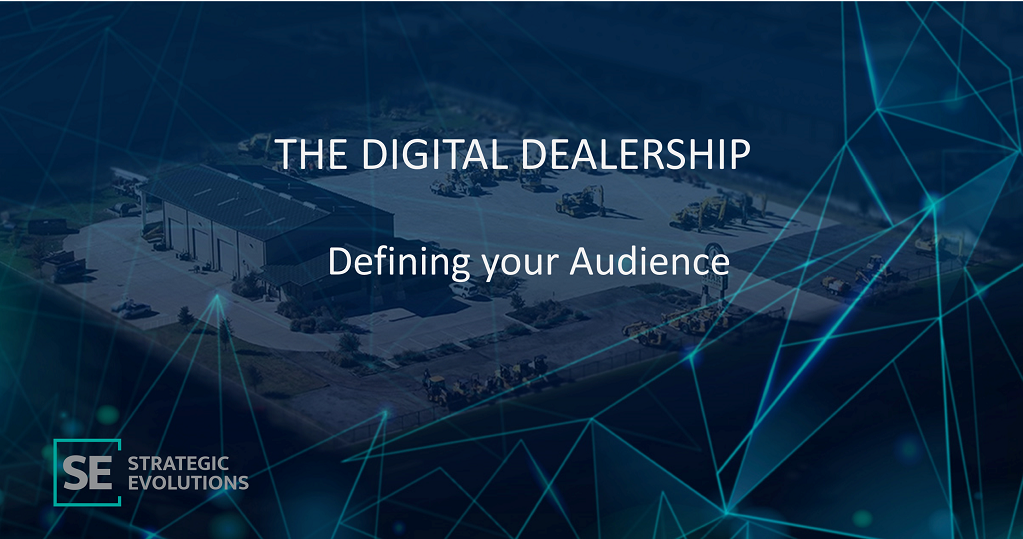
Yet, even with the automatic growth of everyone’s audience, many dealers don’t think about their audience as they build their digital dealership. Many of us think about our customers as audience. Customers come through the door, call our phones and send us emails. Our customers work with us daily, weekly or monthly as they use the equipment they purchased, or are looking for newer equipment. Still, our customers are only part of our audience, even if they are a small and important subgroup.
The broader concept of audience is important for us to consider in several ways. It’s important first when planning our marketing, second in designing operations and finally in developing our strategy. For this article let’s start with Strategy, since it lays the groundwork for the rest.
The first thing to think about is how will you define or identify your audience. What groups of people and companies will you want to draw in and communicate with? This will vary depending on the type of dealership you have, and will need to be adjusted, as you reconsider who your audience is. This is called segmentation.
For example, for a few large, well-established dealers the audience tends to be fairly set. It typically consists of all the users of their brand of equipment, in their territory. Potentially it might only include those customers with accounts in the dealer’s business system. Another example is a smaller farm and yard equipment dealership. Here the number of interactions with each customer will be lower, and the dealership needs to find new customers constantly. A strategic approach to audience segmentation will be different for both these example dealers, but for both, clearly defining it lays the ground work for their business.
To define a dealership’s focus audience, we need to determine what audience segments fit into your strategy. Start with these 3 audience segments or categories. How important is each to your business?
1. Repeat or Existing Customers
2. Prospect Customers
3. Unknown Audience (This is typically where your new leads come from)
Next, consider where your audience members are.
Are they: Local, Regional, National or even farther? How far do you want to reach? How will your strategy differ for those near you and those far away?
With all the audience segments identified, and priority segments selected, we can create a strategy for each of them.
For each segment the dealership wants to reach, 4 main things must be considered. First the message, next the communication channels and third the response method. The final item to be considered is an important part of what makes your dealership the Digital Dealership, it is the integration of known audience information with each strategy.
In creating the strategy dealers need to think about the message. This is often the product they want to communicate to each audience segment. Is the product the machine, the dealer’s experience or something else? Many dealers think they are selling equipment when a significant aspect of value is the dealership. When communicating to unknown audience members, they merely provide the details of a machine in inventory, they forget to include the more important value the dealership brings.
The strategy should consider the channel for communication. Dealers should understand what digital channels and platforms their target audience segments are on, where the audience will see or receive the message. Channels include traditional communications, social media, email etc. Depending on the product and the audience segment, different channels should be used. Don’t use the same channel for everything and assume your message reaches the audience.
An often-forgotten aspect of communicating with the audience is the response method. Typically, the faster the response from the dealer is the better. Also, the response method should more closely matched the original communication method. For example, if people are reading your email, they likely want to respond the same way. We often see dealers mismatching the channel and the response method and seeing poor engagement.
Finally, before we can look at marketing and operations in the next article, we always need to consider the most important aspect of the Digital Dealership, the use of information. This starts by having clear strategies for each segment. By using the information already known about the audience to fine tune the strategy, we get a much more targeted strategy. For example, sending marketing campaigns to customers and prospect customers about a new backhoe, to customers known to have backhoes of a replacement age. Image if your next email campaign started with “Hi Mets, because you currently own a 2012 Case 580SN, we’d like to share information on this 2017 CAT 430F.
In my next article I’ll continue and look specifically at Marketing and advertising to segmented audiences. I’ll also post a work sheet for your dealership to work through to get started.